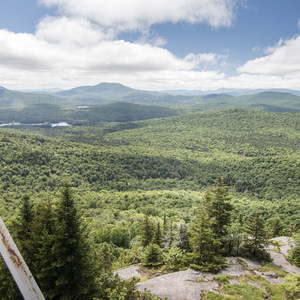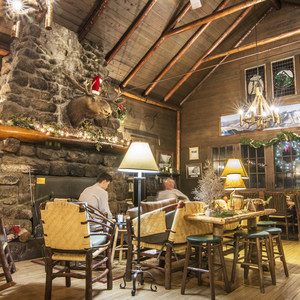Coney Mountain stands approximately 1,000 feet in elevation a few miles south of Tupper Lake. A 1.25-mile trail circles the mountain to a bald summit with an incredible 360-degree view of the surrounding Adirondacks. After a winter snow storm, the trail offers an enticing snowshoe adventure. No other trail in the area seems to offer such rewarding views with such a relatively short trek.
A state Department of Environmental Conservation sign marks a dirt road on the east side of Route 30, which leads up a hill to a small parking area. Look for the registration box and the blue markers at the start of the trail. Ascend the western slope of the mountain through an open forest. A gradual incline will wrap around the northern face and circle the eastern side as the path gains elevation. Finally, a sharp turn to the north leads up a smooth rock slab toward the top with a final incline. The trees will suddenly dissipate as the rocky summit emerges with an open view.
If the snow has melted or blown away at the summit, you will find three U.S. Geological Survey benchmarks and some eye bolts. Tupper Lake can be seen through the trees to the north. To the right of Tupper Lake is Litchfield (Goodman) Mountain (Coney’s twin). Clockwise from Litchfield Mountain is Mount Morris (Big Tupper) and the Sewards. To the east, the snowy tops of the MacIntyres, Mount Marcy, and Santanoni span the horizon. To the south, Blue Mountain can be seen with the faint outline of its radio and fire towers. To the west there are a series of ponds amid the Horseshoe Lake Wild Forest. Depending on the amount of snowfall, the trail can be somewhat rocky, and snow spikes alone may be sufficient to reach the summit.
History
Originally known as Peaked Mountain, Coney Mountain's name changed several times. In 1882, it was incorporated into a triangulation of the county corner, when it was renamed Monument Mountain. In 1891, it appeared on a map as Cone Mountain, which was adapted to its present-day name.
Coney Mountain lies on a historic boundary line that was first marked in 1772 by surveyor Archibald Campbell. He laid out the north line of the Totten and Crossfield Purchase. There were numerous problems with this property line, and it wasn't verified until 1903 and 1904 by the state engineer. Almost 300 steel I-beams and paint blazes were placed along a 50-mile tract that now forms the boundary of St. Lawrence and Franklin counties and Herkimer and Hamilton counties. You can follow these markers as an alternate route to the summit from where the line crosses Route 30 (constructed 1918). Locate the turnaround on the west side of the highway. The faint trail begins across from this location on the east side of the highway behind a utility pole. The first steel I-beam of several, #158, is marked with red and yellow surveyor’s paint and accompanied by blazes. This line through the forest emerges onto the main path slightly south of the peak just as the main trail turns to the north.










Comments
Sign In and share them.